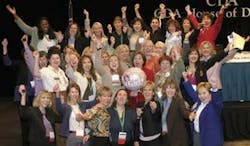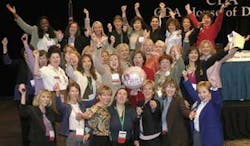A Different Path ... to Leadership
Women dentists accept leadership roles in organized dentistry.
How do I do it? Why do I do it? I am often asked these questions about my leadership in organized dentistry. I suppose the blame can be placed on my extroverted mother who, at age 76, still gives generously of her time to civic and church activities. She has been one of my most important role models. As an introvert, what is it that drives me to give precious time to organized dentistry? My conclusion is that it is a calling.
Leadership in organized dentistry does not appeal to everyone. Attending meetings, reading about dental issues and communicating, whether by phone, fax, or e-mail, all take time away from other activities. Certainly there are rewards, but do they justify the sacrifices? That question can only be answered by those who choose to serve.
In 1970, I shared my interest of going to dental school with my college counselor, and was met with a response indicative of the era. His reply was, “Women do not go to dental school; they become dental hygienists ... honey.” So I became a dental hygienist, returned to my home state of Alaska, and practiced for five years during which time I served as president of the state hygienists’ society. Discussing regulatory issues and working with other dental and state leaders to find solutions really intrigued me. I also served as chair of the advisory committeefor the Anchorage Community College Dental Hygiene Program and began to think about a career in dental hygiene education.
After gaining acceptance into a master’s program for dental hygienists at the University of Washington, I was recruited to teach in the dental hygiene program at Western Kentucky University. While there, I met a recruiter from the University of Louisville who encouraged me to apply to dental school. At that time, the applicant pool to dental schools had declined, although the number of women applying had risen.
After following up on several dental school applications and interviews, I entered the University of the Pacific School of Dentistry in San Francisco.
An early start in dental school
While I was in dental school I followed my interest in education by volunteering as the student representative to the American Association of Dental Schools (AADS), now the American Dental Education Association (ADEA). I served on the AADS Council of Students, became the chair, and served on the Executive Committee as the Vice President for Students. That role led to a request from the American Dental Association to serve as the student representative to the Commission on Dental Accreditation (CoDA).
My CoDA term completion coincided with dental school graduation; however, I continued as a dentist consultant on site visits for allied programs undergoing accreditation. During my post-graduate training in oral medicine and periodontology, I taught dental and dental hygiene students in Dallas and San Antonio. My teaching experience later sparked an interest to serve on a council for the California Dental Association (CDA).
By that time, I had married, had a child, completed my education, moved back to California and started a periodontal practice. In the local dental society newsletter, a request was made for volunteers to serve on CDA councils, including the Council on Membership and Education. Upon requesting more information, I received a return phone call from a local dental leader implying that I needed more experience, and should begin to serve at the local component level before the state level.
Involved with the state association
The president of the local component at the time was a woman who subsequently called to encourage me and offered to nominate me for a CDA council position. Two years later, I became chair of the Council on Education and Public Relations and was the only female volunteer at the Board of Trustee meetings. During my fourth year as chair, I received encouragement to become a candidate for the position of treasurer of the Association.
As a candidate for the Executive Committee, I was required to give a five-minute presentation to the Board of Trustees and answer three questions. I felt it was important that I represent women well even if I was not elected. My speech preparation and delivery helped me to become the first woman to serve on the executive committee. This placement acknowledged several barriers that were broken down - I had not served as a component leader, a CDA delegate or trustee, not to mention my former dental hygiene career.
The decision to be active in organized dentistry is a personal one. I believe that it is more difficult for women to keep a balance, especially if juggling family and practice responsibilities in addition to volunteer activities. Last year, as wife, mother of four, owner of a solo periodontal practice, and president of the California Dental Association, I found that what I relinquished most often was personal time.
In dentistry, we know the importance of teamwork and it is no different whether in the office, at home or volunteering. I am blessed with responsible and caring teams who assisted me in all of my roles. My husband was able to accompany me on most of my travels, often driving while I worked on a presentation and setting up my laptop and projector. The family learned to be more self-sufficient and I admit there were many pre-prepared meals. At the same time, my children were able to witness the respect and benefits that accompany leadership.
I learned to multi-task like never before, checking email on my wireless laptop while dressing, participating in conference calls via cell phone while driving children to activities, and reading meeting materials while riding the exercise bike. I spent two to three hours per day on CDA related activities, and one to two days per week away from my practice. I had the advantage of being only 30 miles from the CDA offices, and I hired an associate to help with the patient load. Email was an important tool as it allowed me to correspond at my convenience, between patients or late at night instead of having interruptions during patient treatment.
When asked if I would do it again, my answer would be most definitely “yes,” but when asked if the term should be more than a year, I would say “no.” Some people ask where do I get my calmness, and my reply is, “From my faith.” I would not be able to keep perspective without it.
The past and the present connections
It has been a tremendous honor to serve. Taveling up and down California and across the United States has lent me the opportunity to meet remarkable people, dentists, and others. More importantly, I have a sense of giving back to the profession and participating in improving dentistry in some small way. I feel connected and informed about the current issues. The friends will remain but what I fear most about not being involved at the same level is not knowing what is on the horizon for dentistry, what the current legislative and regulatory issues are.
Dental organizations should make an effort to involve past leaders to utilize their knowledge, insight, and relationships. Often, once a leader has completed the top level in an organization, they are no longer engaged. Dentistry should also enhance recruitment, training, and support of its leaders while making a concerted effort to increase the diversity. This is particularly true if women are to be successful leaders in organized dentistry. Those who express an interest in becoming involved should be encouraged and provided with leadership training. Governance models that allow for a variety of leadership roles are important. Many women dentists and new dentists are not interested in serving 20 or more years to become an officer of a dental organization.
The California Dental Association recently decreased the number of standing councils in favor of a task force model. Advantages of a task force include the ability to enlist expertise for a particular issue, often requiring a shorter term of service. In addition, CDA has replaced its screening committee with a leadership development committee that will recruit and train new volunteer leaders.
Leadership skills are rarely taught in dental education programs; therefore, it is important that dental organizations provide training and support to leaders. If organized dentistry is to truly represent all dentists, including new dentists, those raising families and those working in underserved areas, we must provide encouragement and assistance for them in leadership roles.
The face of dentistry is changing and the faces of dental leaders must also change if we are to be successful in representing our profession. I invite and encourage you to become actively involved, to help determine the future of oral health care.
Debra S. Finney, MS, DDS
Dr. Debra S. Finney practices in Folsom, Calif. She can be contacted at [email protected].


